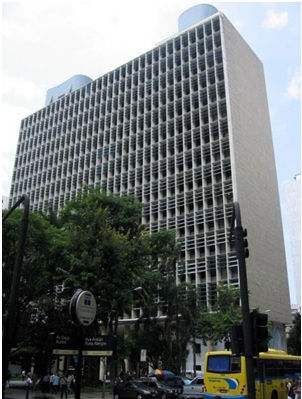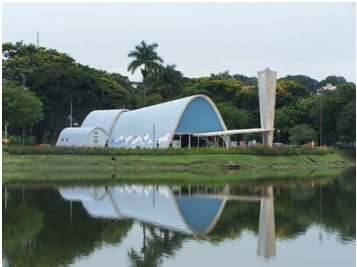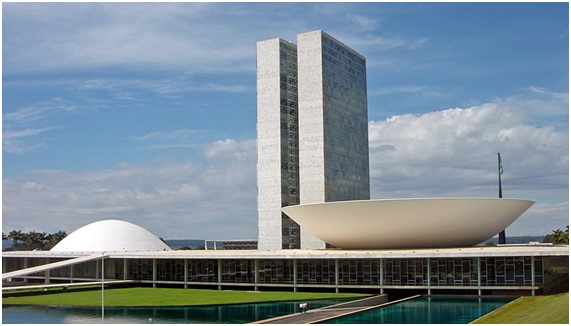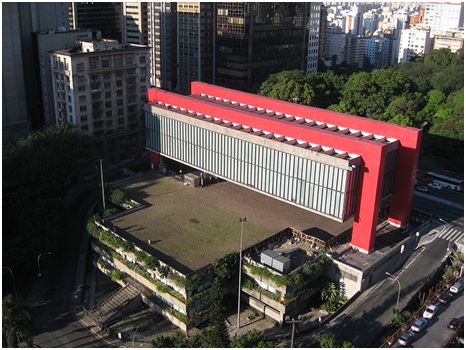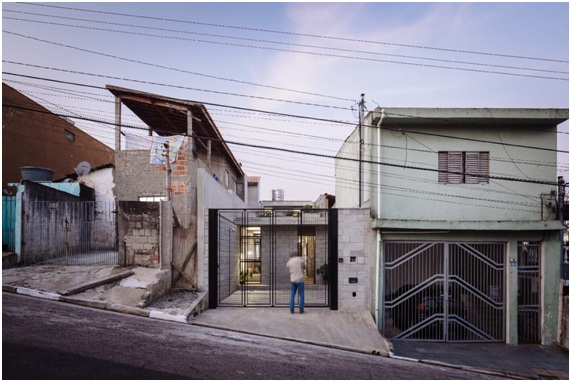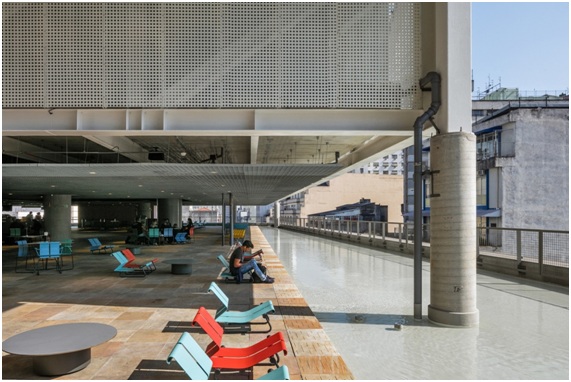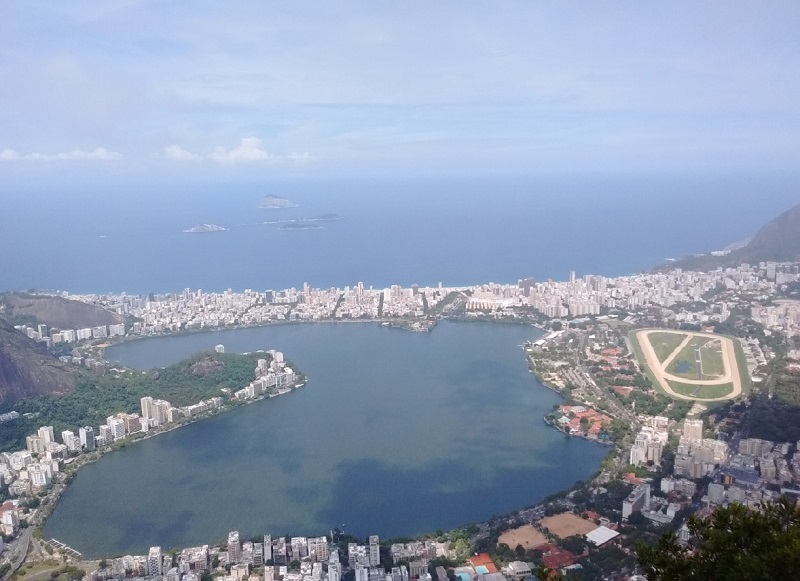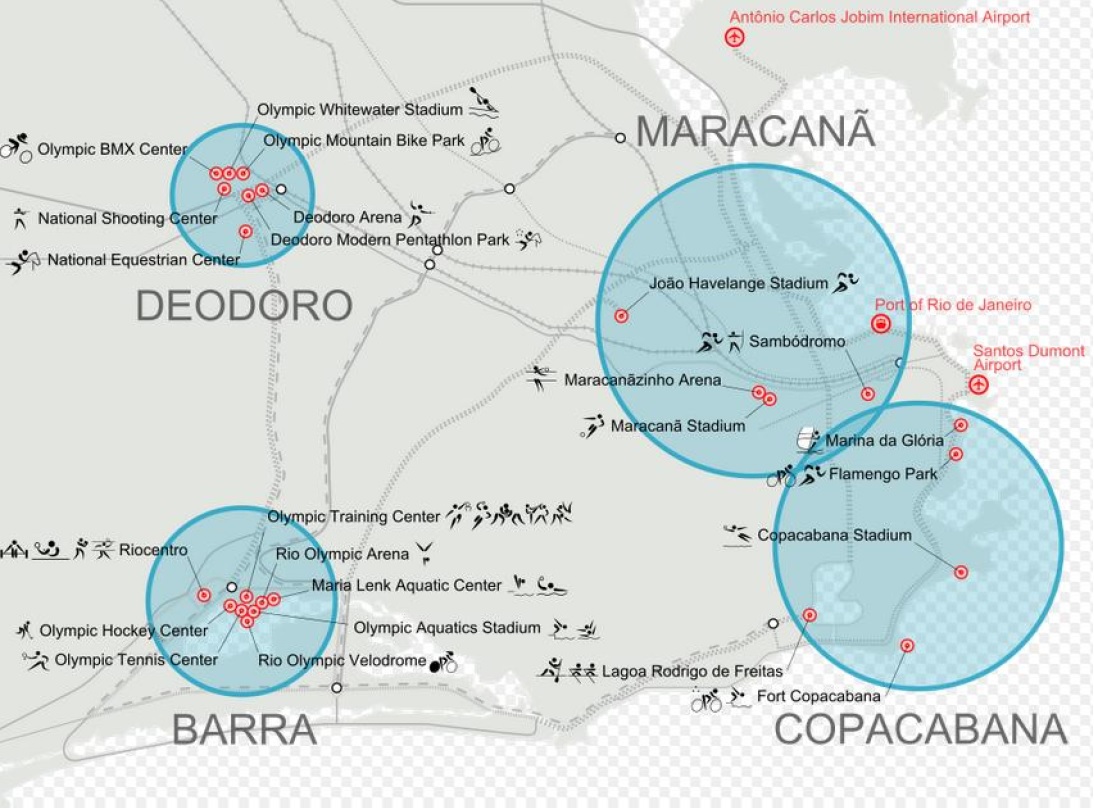Brazilian Perspectives
Leonardo Poletti - Architect and Urbanist, Specialist in Civil Construction - Partner of the Brazilian Offices 3C Architecture and Urbanism and Entre - Architecture of Solution
Brazilian Architecture - Contemporary production and reality of the professional market | Part II
September 6th, 2019Before continuing the article published last year, I owe sincere apologies to the readers of Urban Realm for the long time since the first post. The last months have been very busy here in Brazilian lands, reflecting directly on my professional performance, with new and varied work fronts emerging in my work routine as an architect and urban planner. Consequently, new challenges and obstacles were also emerging, which required focus and very concentrated efforts in this new scenario that came to me. But let's move on.
Part I of the article concludes by addressing the current characteristics of architectural production in Brazil. Some examples have been presented of how architectural production has responded to the challenges of our reality, with examples that stand out positively in a challenging scenario.
As mentioned above, besides being common knowledge, we are talking about a poor country with serious socioeconomic needs, aggravated by an invariably troubled political scenario throughout its history, but which has been especially confusing and tense over the last 5 years.
All this instability ends up curbing investments in construction, both by the public and private initiative. Thus, the immense need that Brazil presents for infrastructure works, major urban interventions related to mobility, offerings of qualified public spaces that could provide leisure options and reflect on the security of the population, are not only being supplied but have been increasing exponentially. Added to this there is a huge housing shortage, which the government often seeks to address with offers of low quality architectural and constructive housing, even though it is not necessarily cheap for the public coffers. Thus, it is evident the great demand for qualified and responsible projects with the public purse.
However, it is possible to verify that this lack for qualified projects is not related to the absence of architects graduated from Brazilian universities. On the contrary, ironically there are a huge number of professionals, especially recent graduates, who are unable to enter the job market. And the most striking fact is that today the number of students in our universities is greater than the total number of graduates. That is, the market saturation scenario tends to get worse.
Nevertheless, this does not mean that previously exposed issues will be resolved automatically or in a short time. Many of the newly entering architects come from colleges with little tradition and that don't offer the minimum conditions for quality teaching to their students, some of which has adopted the distance learning modality*.
It should be noted, however, that this is not the rule. There are a large number of universities, both public and private, offering high quality education and fully trained professionals. What happens is that by placing in the same market professionals with huge technical lags in their training, but in equality with regard to their attributions, the image before the Brazilian society of all architects ends up compromised. Added to this is the resistance that most of our architects have to adopt new tools, such as BIM softwares, and our culture of diminishing the relevance of design compared to the execution of the works themselves. The result is that the contribution that our architects and urban planners could - and should - offer to Brazilian society is little explored. It also helps explain why we live in a culture of not hiring architects, especially among the lower classes. The case of Casa Vila Matilde, from Terra and Tuma office (exposed in part I of the article), is an exception to this rule and, precisely because it is an exception, had a great and positive repercussion among professionals in the area.
Analyzing the issue from this perspective, it is possible to understand how there is still room for the contribution of foreign architects in the improvement of architecture in Brazil, especially by bringing the experience of developing executive projects with high level of detail, compatibility, specifications and rigor in technical solutions. It would certainly be a huge contribution in a scenario of tight budget constraints but which, nonetheless, routinely presents examples of overpriced works, especially in the public sphere.
However, there are some challenges for foreign architects to be able to operate in the Brazilian market. It can be said that the biggest one is the bureaucracy that involves the process of obtaining the license to practice the profession here. In fact, the bureaucracy - another typical feature of our culture - is a huge obstacle for the performance of Brazilian architects themselves here in our country. Another point to consider is the unattractive fees normally paid to the category, which are even less attractive with the current devaluation of our currency. On this point, however, it is important to note that the Council of Architecture and Urbanism, an entity that defends and regulates the performance of architects in Brazil and that was established only in 2011, has been acting strongly in valuing the profession, seeking to establish clear criteria to standardize and increase our professional fees. Finally, foreign professional performance in projects on Brazilian lands demand, as in any other country, knowledge of legal, technical and environmental constraints, and because of their immense territorial extension, such constraints vary significantly between Brazilian regions.
As a way to overcome these challenges, foreign architects interested in working here may consider establishing partnerships with Brazilian professionals. This practice has been observed for some time and gained strength during the preparation of the two major sporting events hosted in Brazil in recent years. There are numerous local offices open to this exchange of experience and work opportunities, especially those with the involvement of younger architects, who are increasingly interested in acting globally, in an environment of information and knowledge exchange. . There is a huge field open for such integration to take place, which will undoubtedly contribute to establishing and strengthening the culture of architectural design among Brazilian society.
*This theme may become the topic of another article in the coming, as it has generated great controversy among professionals, private educational institutions and class entities.
PS: In the next article I will share my experience developed over the last months, during which I followed the execution of works of 5 public buildings that will house activities aimed at young people living in the outskirts of a large metropolitan region and exposed to a reality of great social vulnerability.
Brazilian Architecture - Contemporary production and reality of the professional market | Part I
March 5th, 2018This article seeks to bring a picture of the architectural production currently developed in Brazil, as well as discuss the reality of the professionals who work in the area, covering both those born in Brazilian lands and foreigners who come here looking for opportunities to develop their projects.
The understanding of the characteristics of the contemporary Brazilian architecture necessarily passes through a re-reading of its history as it brings evident reflexes in the current production. Although other periods, especially the Colonial, the Eclectic and the Art Deco have produced examples of magnificent buildings, this retrospect takes as its starting point the modern architecture, which in Brazil has its first records dated from the late 1920s.
Modernism in Brazil - first phase or Carioca School
As is well known, it was during modernism that Brazilian architecture became internationally recognized, gaining space in exhibitions and publications from the production of names such as Lucio Costa, Affonso Eduardo Reidy and Oscar Niemeyer. Starting from the principles of the International Style, the movement of architects formed by these and other names developed a production that incorporated elements of local reality into Le Corbusier's canons. In this aspect, Lucio Costa can be considered one of the main responsible for the incorporation of traditional elements of the Brazilian architecture during the modernist period, due to its fascination for the works of the period in the Brazilian colonial period. Even the early years of his professional career are marked by the production of a work inserted in the neocolonial movement that emerged in the early twentieth century that sought to rescue the country's authentic cultural roots and fight against international trends.
The Brazilian adaptation to the modernist movement also included the participation and guidance of Le Corbusier himself, who in 1936 was hired by the Brazilian government to act as consultant on the project of the building of the Ministry of Education and Health, authored by a group formed by Costa, Reidy, Niemeyer, among other names. The project incorporated the elements that would come to be recognized as the basis of Brazilian architectural modernism, such as the use of pilotis, use of local materials like tiles, adjustable brise-soleil systems, among others. It also had the peculiar and unmistakable landscape design of Roberto Burle Marx, an indissociable name of the great modern Brazilian works. As a result, the Ministry building, now known as Gustavo Capanema Palace, gained international prominence and is considered one of the most important modernist creations on the American continent.
Gustavo Capanema Palace - Photo by Imagens AMB
The first cycle of Brazilian modernism, which dates back to the mid-1950s, became known as the "Carioca School", due to the fact that the main names of the architecture of the time were working in Rio de Janeiro. In this period, the most prominent name is undoubtedly Oscar Niemeyer, whose work contributed in a fundamental way to the consolidation of the modernist school, including raising it to the official style adopted by the Brazilian government.
Among the many outstanding examples of Niemeyer's work, the first that deserves further attention is the Pampulha Architectural Complex, built in the early 1940s in Belo Horizonte. This complex is composed of a series of buildings arranged along the banks of an artificial lake, in a noble area of the capital of the state of Minas Gerais. The complex includes a casino, a dance hall and restaurant, a yacht club, a golf club and a church, as well as a weekend house specially commissioned by the then mayor of the city, Juscelino Kubitschek, who later became the president who would entrust to Niemeyer the project of the new Brazilian capital, Brasilia.
Among the buildings built in Pampulha, the most prominent is the Sao Francisco de Assis Church. In it the architect explores the plasticity of concrete through curved shapes, unlike the linear geometry in which it was commonly used until then.
Sao Francisco de Assis Church - Photo by Bernardo Gouvêa
After the success achieved with his work at the Pampulha Complex, Niemeyer was hired to develop numerous projects, where he was able to develop his modernist precepts adapted to the Brazilian reality and to his own convictions. The culmination of his career comes in the late 1950s, when he assumes the responsibility, along with Lucio Costa, to develop the projects for the construction of Brasilia. While Costa was in charge of developing the Pilot Plan, which sets the guidelines for the development of the city, Niemeyer projected the whole built set. One of the greatest challenges for the architects was the short time for the elaboration of the projects and their execution, since the order of President Juscelino Kubitschek was that the capital should be inaugurated during his term. So, between the beginning of the projects in 1956 and its inauguration in 1960, they had little less than 4 years.
The built set designed by Niemeyer for Brasilia ended up being developed under the influence of the critic that his work began to receive at the time. In this way, the Alvorada Palace (presidential residence), the National Congress Building, the Planalto Palace (seat of government), the Brasilia Cathedral and the ministries' buildings, among others of its responsibility, adopted a "simplification of architecture" proposed by Niemeyer himself. This architecture would become an expression of the structure through pure volumes, prioritizing the aesthetic impact over other programmatic functions, justifying that "when the form creates beauty, it has in its own beauty its justification."
National Congress - Photo by Mario Roberto Duran Ortiz
The construction of Brasilia was controversial, since the precepts of modernist urbanism were already criticized even before the construction began, due to its monumental scale, the prioritization of the form over the function and the relevance given to the car. Even with all those critics, and though it is quite recent, due to its historical importance, influence and impact, the city was declared Cultural Heritage of Humanity by UNESCO in 1987.
Modernism in Brazil - second phase or Paulista Brutalism
Still during the 1950s, fueled by the criticism to which the architectural production of the time was subjected and also by the trends observed in other countries, a new movement began to gain strength in Brazil, opposing, even though implicitly, the guidelines adopted by the Carioca School, but still under the influence of modernist ideals.
This movement, now based in the city of Sao Paulo, was known as "Paulista Brutalism" and had as its main names Joao Batista Vilanova Artigas, Paulo Mendes da Rocha, Carlos Milan, Lina Bo Bardi, among others. This strand advocated the formulation of a clean, clear and socially responsible architecture, following the aesthetic ideals of European Brutalism. It is commonly associated with the massive use of apparent concrete and a suppression of leaked elements and greater use of blind gables.
Perhaps due to the fact of conforming as a counterpoint to what was known as " the Brazilian architecture", the work produced by this movement did not obtain a great international repercussion, which leads many to believe that such Brazilian architecture ended with the inauguration of Brasilia. However, there are architectural examples of great relevance produced in the 1960s and 1970s, among which we can highlight the Gymnasium of the Club Atletico Paulistano, by Mendes da Rocha (1968) and the Sao Paulo Museum of Art (1958) and the SESC Pompeia (1977) by Lina Bo Bardi.
Sao Paulo Museum of Art (MASP) - Photo by Benjamin Thompson
Postmodernism and contemporary architecture
The postmodern current that established itself worldwide between the 1950s and 1960s began to be observed in Brazil only from the 1980s, as the modernist ideal remained heavily impregnated in its architectural production. However, although late, the questions related to the untying of the buildings to the site context, monumental scale and impersonality, typical characteristics of modernism, became do gain more and more space among Brazilian architects.
In practical terms, the postmodern movement had little representation in the Brazilian architectural production, with rare examples that deserve greater prominence. Its major impact is related to its role in attenuating the dominant hegemony of modernism and opening possibilities for new directions.
From the twilight of modernism, the principles that guide the contemporary Brazilian architecture begin to gain strength. Nevertheless, it is important to emphasize that, although it has lost its force, the modernist language is frequently observed in the current local architectural production, especially since it is adopted as a reference for many of the Brazilian architecture universities, especially the public ones. In any case, the non-abandonment of this period of extreme importance and relevance to Brazilian architecture is perfectly identified with one of the premises of current production, of looking at the past without denying it and of seeking references but without becoming a hostage of them.
In addition, contemporary architectural projects have sought - even if we are far from having only good examples - integration with the city, constant incorporation of technological innovations, detailed specification of construction systems, concern for comfort, energy efficiency and with care with the environment, all without ever losing focus of the local characteristics.
It has also been observed, especially due to globalization and the rapid dissemination of information, the development of projects aligned with the production found in the most varied parts of the world, especially with regard to formal- aesthetic language. Still, noteworthy examples such as those developed by the FGMF office, Brasil Arquitetura (led by Marcelo Ferraz, disciple by Lina Bo Bardi) and Estudio 41 are able to transcend this kind of architecture pasteurization with the inclusion in their projects of the principles mentioned above. Thus, a good number of very well designed buildings have been appearing more frequently in Brazilian lands, with constructions that fit well into the urban mesh and converse harmoniously with their surroundings through scale and proportion. As well, they understand the local reality of budget limits and social fragility typical of a poor country that is going through a period of severe economic recession. Under this latter aspect, it is worth mentioning the production of an architecture that serves the lower social strata with quality, for example, the projects from Terra and Tuma Arquitetos Associados.
Vila Matilde House (2015) by Terra e Turma Arquitetos Associados - Photo by Terra e Tuma Arquitetos Associados
It is possible to perceive that, although there is often the understanding that Brazilian architecture ended along with Niemeyer's project for Brasilia, it continued to evolve and produce works of immense relevance and significance. Maybe this perception is linked to the near stagnation of Niemeyer's own work, undoubtedly the most renowned Brazilian architect, but who, despite his self-criticism, continued until the end of his life projecting without definitively overcoming the concepts of Brazilian modernism of the 1940s and 1950s.
On the other hand, numerous examples of great architects and significant works have followed and continue to emerge. This can be clearly portrayed by the work of Paulo Mendes da Rocha, who followed the evolution of Brazilian architecture, beginning with the modernism of the Paulista strand, passing through postmodernism and reaching the contemporary architecture. He understood the correctness of each period, at the same time that he accepted the criticism of each one of them. Reflected on his own work and continues to produce projects that are correctly positioned in their time. The awards he received, among which the Pritzker in 2006 and the Golden Lion of the Venice Biennale in 2016 undoubtedly certify the high level of his architectural production, and consequently of Brazilian architecture, from the past and the present.
SESC 24 de Maio (2017) - by Paulo Mendes da Rocha + MMBB Arquitetos Associados - Photo by Nelson Kon
__________________________________________
PS: the second part of this article will discuss the current reality of the architecture market in Brazil, addressing the real demand for professionals and the absorption capacity of architects already graduated and those who will soon enter the market. It will also deal with the areas of work with the greatest lack of qualified professionals, financial return and the possibilities of professional action for foreign architects.
A look at the legacy of the Olympic Games in Rio de Janeiro
November 9th, 2017In 2009 the city of Rio de Janeiro was chosen as the host city for the 2016 Olympic Summer Games, beating Madrid, Tokyo and Chicago in the final vote. It was a reason for pride and celebration for the Brazilian people who, at the time, lived in a heady optimistic atmosphere fueled by good results from the domestic economy. At that moment there was certainty that Brazil was finally moving in solid steps towards expected future prosperity.
Having the honor of hosting the Olympics reinforced this impression. Rio would have the opportunity of undergoing transformations similar to Barcelona in 1992, or like London was going through. By the way, as we had the opportunity to see how the British were preparing for the games, the policies that were being implemented in the city, the legacy being built and finally the result both in the organization of the event and in the performance of the British athletes, our own expectations of going through the same experience also grew.
The propaganda sold by the Brazilian Government and the Olympic Committee (COB) before and during the games was that the legacy that would be left in Rio would radically change its reality. The symbolism of the Olympic spirit was exhaustively used as the catalyst for the new moment that our nation was entering. And Rio de Janeiro, recognized worldwide for its natural beauty, could indeed be called the Marvelous City in every respect. The planned works would promote a long-awaited revolution in public transport through the implementation of a mobility policy. There would be the pacification of violent communities through urbanization of the slums and effective actions to combat drug trafficking, which would reflect in the safety of the entire population. In addition, structures would be built that would allow the social inclusion of young people in situations of social fragility through Olympic sport. All based on respect for natural resources, promoting urban development following the most rigorous environmental sustainability principles.
In 2012, once the London games were over, we turned our gaze more closely to our own preparations and started to project how the games would look like on Brazilian soil. It was then that we began, gradually, to return to our reality. While in the British capital we observed the previously decayed and degraded Stratford area become a large and qualified public space for leisure and sport, here, the key constructions to host competitions and promote improvements in public transport were being delivered very slowly. Worse, projects such as sewage collection and treatment to help clean up the Guanabara Bay and the Rodrigo de Freitas lagoon, which would also host competitions but above all carried the symbolism of being the great actions related to the environmental legacy of the games, were increasingly doomed to being left on paper. Unfortunately that was what actually happened.
Rodrigo de Freitas Lagoon
At this point it is important to draw a parallel between the cities that hosted the last two Olympic games and the different way in which they approached their preparation. While in London the focus was to revitalize a specific area - the Lower Lea Valley - and to concentrate there the main part of the structures to host the games, in Rio de Janeiro it was chosen to spread the structures around several parts of the city. The choice of the venue for the construction of the Olympic Park, where a lot of the arenas of competitions were erected and also the Village of the Athletes, generated the most controversy. This is because this venue is located in an area far from the city, which necessitated the construction of a heavy network of infrastructure that passes through a large urban void that serves an insignificant portion of the inhabitants of Rio de Janeiro. To give you an idea, the expansion of the subway line to this area consumed 25% of all funds invested to carry out the games. And to this day some of the stations have still not been delivered. It is difficult not to judge this investment as disproportionate, even though the benefits related to urban mobility that this intervention brought to the West Zone of Rio are undeniable.
Venue map prepared by Felipe Menegaz
A comparison between the two approaches allows us to identify the great difference in the legacy left by the Olympics in the two cities. In London, as soon as the games were concluded, the British capital already had a consolidated plan to conduct the Olympic legacy. The region that hosted the competitions gained an efficient network of transport infrastructure and new buildings. The Olympic Park has been renovated and opened to the citizens, offering them leisure options and sports facilities, although a good part of them demand tickets to be used. Still, negative points are identified, especially with regard to the high real estate valuation that the region has gone through, which has put pressure on former residents to leave the region. The promise to keep half the new housing built in the "economically accessible" category has not been fully met. Consequently, the sense of community that until then existed in the region was lost.
In Rio de Janeiro the approach was much more ambitious. In a city that presents the most diverse and serious deficiencies of a quality public service, the option to scatter competitions to different parts of the city could be understood as the most appropriate, after all it could benefit a larger portion of its population. The big question is that the problems that the city presented (and in most cases still present) were really chronic, and therefore it was imperative to build new, complete and complex infrastructure networks that demanded astronomical sums of money. And this money was almost always withdrawn from the public coffers, which by this time were no longer as full as they had been in 2009. This scenario put Rio's organizing capacity to the test to leave the city in a position to receive the Games. Unfortunately the result was works completed in haste, some of which are still unfinished, many of which today are abandoned, practically all of them overpriced. And that, so far, have not brought significant benefits to the most deprived part of the Rio`s population.
Of course the Olympic Games in Rio de Janeiro did not leave only bad examples. Even before being chosen as a host city, globally recognized social inclusion programs were implemented there. The "Favela Bairro" and "Rio Cidade" (Slum District of Rio City, literally translated) programs, idealized by the architect Luiz Paulo Conde, who in 1995 was the municipal secretary of urbanism, promoted transformations in several poor communities of the city, besides urban requalification interventions in the so-called "formal city". Conde never hid his desire to transform Rio into an Olympic city and, in addition to promoting social well-being for the most needy population in the city, these programs were thought of as a way to show the world the capacity of Rio to overcome its problems, thus deserving of receiving the biggest sporting event on the planet.
As part of the effective process of the city`s preparation to receive the Olympic Games, we can cite the case of the central and port area of Rio de Janeiro. Until then completely degraded and abandoned, it underwent a revitalization process, with the installation of new museums and tram lines, among other actions, which promoted a reappropriation of this area by the population of the city. It should also be mentioned that new BRT and subway lines promoted undoubted gains to the urban mobility. Some of the structures of the mounted arenas will be dismantled and reconstructed in new places, turning into public schools. The pool in the region of Deodoro should also be open to the public, becoming a leisure option for the low-income population residing on the site. The offer of rooms in the city`s hotel chain more than doubled in this period. In addition, it cannot be omitted that the period of the games was a great party, which attracted millions of tourists from all over the world, heating the local economy. We can also cite the good performance of some Brazilian athletes that were trained in programs that promote social inclusion through sport.
Tomorrow's Museum (Projected by Santiago Calatrava)
Looking only from this perspective it could be said that the Olympic Games left a positive legacy to Rio de Janeiro. But it is extremely difficult to separate the analysis of the Olympic legacy from the corruption scandals that began surfacing after the Games ended. In the last few months the Brazilian people have had daily access to the news that confirmed the frauds, bribes and superfluous works of all kinds that occurred during the preparation of the Games. In addition, it is clear that a good part of these projects were conceived not for the well-being of the people of Rio de Janeiro, but were mainly aimed at meeting the interests of large construction companies and corrupt politicians who got millions of dollars diverted from overpriced projects. We can still take into account the evident process of real estate speculation in areas that have received substantial works, benefiting certain groups of private investors. Recently the president of the COB was arrested. Among his undeclared possessions consisted of 16kg in gold bars ... Yes, gold! There is nothing more emblematic, considering what this element represents for Olympic athletes. And this "award" was the result of their involvement in criminal negotiations that began even during the process of choosing the host city in 2009, and which in fact became more profitable when the works of the Olympic facilities and infrastructure of the city began to be carried out.
Before the president of the COB's arrest, the former governor of the state of Rio de Janeiro, Sergio Cabral, was arrested, as well as numerous members of his team and businessmen who were attached to him. There are several charges against Cabral, some of which are related to fraud in the choice of Rio as the host city, as well as diversion of public resources in the execution of the structures to host the games. The current reality is that the state of Rio de Janeiro is bankrupt, with no resources to invest in schools, hospitals, security or even to pay the salaries of its public employees.
The opening ceremony of the Olympics in Rio had a moment of enormous symbolism, where the athletes deposited in totems that formed the design of the Olympic arches the seed of 13 thousand trees, that later would be planted in one of the places of the competitions and there would form the "Forest of Athletes ". Believe it or not, the seedlings of these trees have still not been planted, they are being kept in a greenhouse and are not expected to be taken to their final destination. This may be considered a good portrait of the Olympic Games in Rio de Janeiro: an event promoted from excellent ideas, but eventually lost through the process by the mismanagement of those who were responsible for it. Yet, just as there is still hope that these trees can overcome the bureaucracy and inefficiency of Brazilian public power and actually grow and flourish, there are good examples that the Olympics allowed them to be planted in Rio de Janeiro. And in the same way, there`s still the hope that these examples will overcome the endemic practice of corruption and political neglect that have long chastised the Brazilian people, grow strongly and continue to sprout spontaneously not only in Rio, but in all Brazilian cities.


